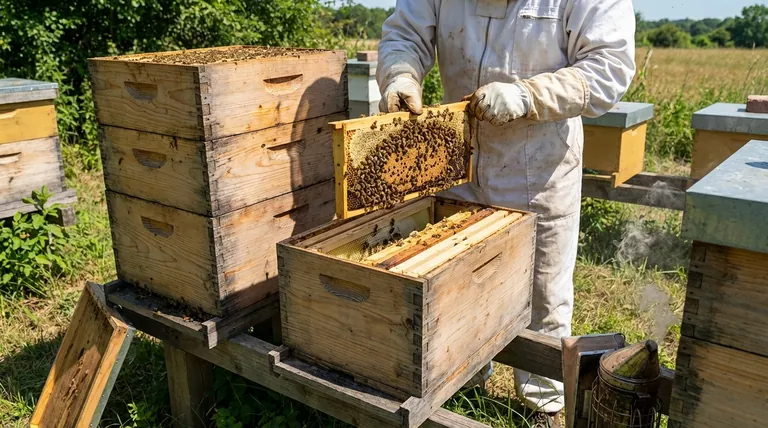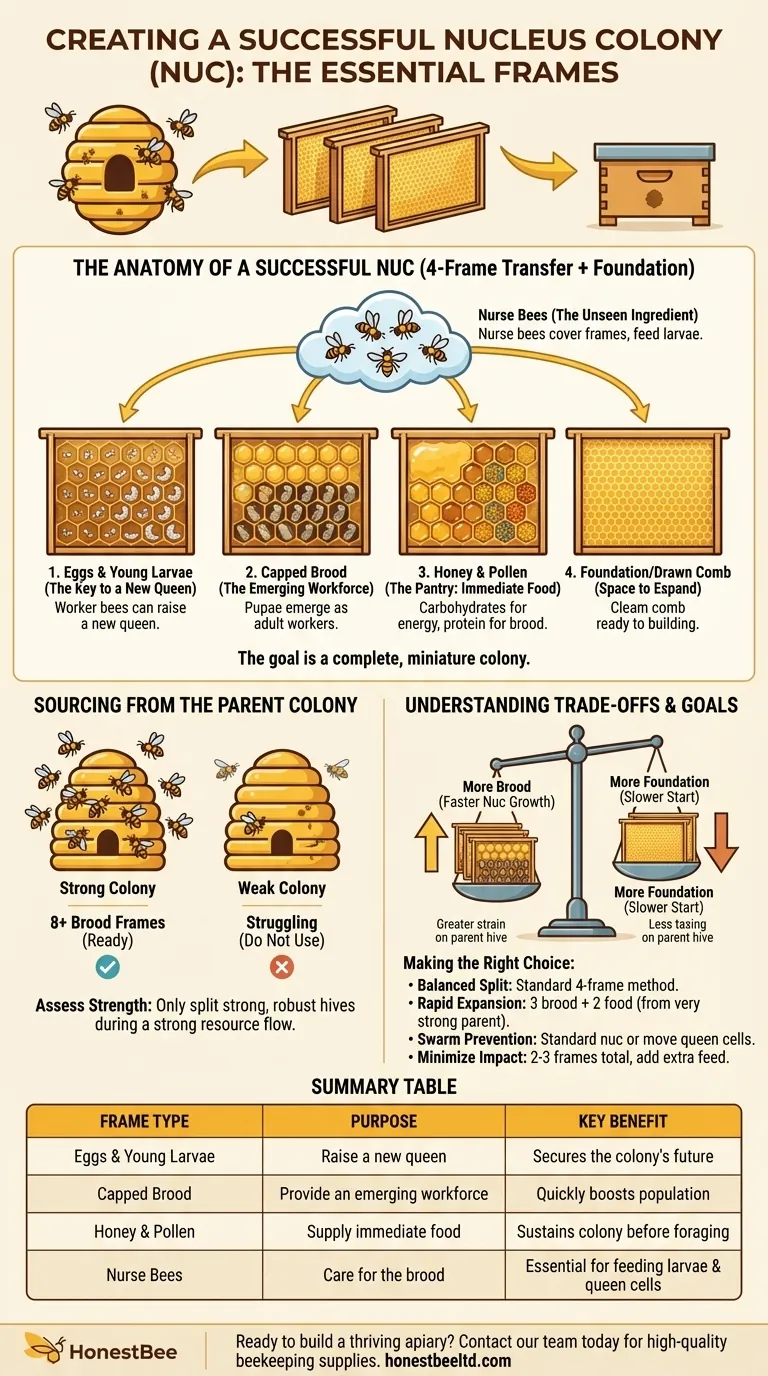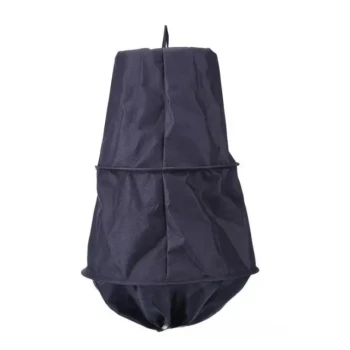To successfully create a nucleus colony, you must provide it with a balanced collection of resources from the parent hive. The most common and reliable configuration is to transfer four frames covered in bees: two frames containing eggs and young larvae, one frame of capped brood, and one frame of honey and pollen for food. You will then add one frame of new foundation or drawn comb to give the new colony space to expand.
The goal is not just to move bees, but to establish a complete, miniature colony. A successful nuc requires a future workforce (capped brood), the ability to raise a new queen (eggs), and the immediate resources (food and nurse bees) to sustain itself through its initial, vulnerable stage.

The Anatomy of a Successful Nuc
Creating a nuc is an act of cloning a superorganism. Each frame you select serves a distinct and critical purpose for the new colony's survival and growth.
The Frame of Capped Brood: The Emerging Workforce
This frame is the nuc's short-term population engine. The pupae under the wax cappings will soon emerge as adult worker bees.
These new bees are vital. They immediately increase the colony's population, replacing older bees and ensuring there are enough workers to forage, build comb, and care for the next generation of brood.
Frames of Eggs & Young Larvae: The Key to a New Queen
These frames are the most critical component if you are not introducing a mated queen. Without eggs, the nuc has no way to create a queen and is doomed to fail.
Worker bees will identify several of the youngest larvae and feed them a special diet of royal jelly. This changes their development, allowing them to grow into a new queen instead of a worker.
The Frame of Food: Honey & Pollen
A frame containing both honey (carbohydrates for energy) and pollen (protein for raising brood) is the nuc's pantry.
This food supply is essential because the new, small colony will have a limited number of foragers. They need these stored resources to feed themselves and the developing brood until the workforce is large enough to gather sufficient nectar and pollen.
The Attendant Nurse Bees: The Unseen Ingredient
It is crucial that all frames you transfer are well-covered with bees. The most important bees are the young nurse bees, which are typically found on frames of open brood.
These bees are responsible for feeding the larvae and the new queen cells. Without a critical mass of nurse bees, the brood will be abandoned and the nuc will collapse.
Sourcing Your Frames: The Parent Colony
You can only create a strong nuc from a strong parent colony. Taking frames from a weak or struggling hive will likely result in the failure of both colonies.
Assess Parent Colony Strength
A healthy, robust hive ready for a split will typically have at least eight frames of brood in various stages. Taking 3-4 frames from a colony of this size will slow its growth, which can help prevent swarming, but it won't cripple it.
Ensure a Strong Resource Flow
The ideal time to make a nuc is during a strong nectar and pollen flow. This provides the parent colony with the resources to quickly replace the frames you removed and gives the nuc ample foraging opportunities.
If you must make a split during a nectar dearth, you should feed both the parent colony and the new nuc a 1:1 sugar-water solution to stimulate growth and comb-building.
Understanding the Trade-offs
The "recipe" for a nuc is not absolute. The number and type of frames you take involve balancing the needs of the nuc against the health of the parent hive.
More Brood vs. More Foundation
Taking more frames of brood (e.g., three instead of two) will create a more powerful nuc that builds up much faster. However, this places a significantly greater strain on the parent colony.
Conversely, taking fewer brood frames and providing more empty foundation is less taxing on the parent hive but means the nuc will have a slower start.
The Queen Cell Method
If you find a parent colony already preparing to swarm, you can take a frame that contains fully developed queen cells. This is an excellent method for swarm control.
A nuc started with queen cells will have a new queen emerge much faster than one started with only eggs, giving it a significant head start.
The Risk of Weakening the Parent Hive
The most common mistake is being too aggressive when taking frames. Removing too much brood can severely weaken the parent colony, making it vulnerable to pests like wax moths and small hive beetles, or unable to collect enough honey for winter. Always prioritize the long-term health of your original hive.
Making the Right Choice for Your Goal
Your strategy should align with your primary objective. Use these guidelines to decide on the best configuration for your situation.
- If your primary focus is a standard, balanced split: Use the classic 4-frame method: one capped brood, two open brood/eggs, and one food frame.
- If your primary focus is rapid colony expansion: Create a stronger nuc with three frames of brood and two frames of food, but only if the parent colony is exceptionally strong (e.g., 10+ frames of brood).
- If your primary focus is swarm prevention: Make a standard nuc or, if queen cells are present, move a frame with queen cells along with frames of brood and food into the nuc box.
- If your primary focus is minimizing impact on the parent hive: Take only two or three frames total, ensuring at least one has eggs and one has food, and provide the nuc with extra feed to compensate.
By understanding the function of each frame, you empower yourself to create healthy, resilient new colonies tailored to the needs of your apiary.
Summary Table:
| Frame Type | Purpose | Key Benefit |
|---|---|---|
| Eggs & Young Larvae | Raise a new queen | Secures the colony's future |
| Capped Brood | Provide an emerging workforce | Quickly boosts population |
| Honey & Pollen | Supply immediate food | Sustains the colony before foraging begins |
| Nurse Bees | Care for the brood | Essential for feeding larvae and queen cells |
Ready to build a thriving apiary? Creating strong nucleus colonies is fundamental to successful beekeeping. At HONESTBEE, we supply commercial apiaries and distributors with the high-quality beekeeping supplies and equipment needed for every stage of hive management. From nuc boxes to essential tools, our wholesale-focused operations ensure you get the reliable gear your business depends on.
Let's grow together. Contact our team today to discuss your needs and discover how HONESTBEE can support your success.
Visual Guide

Related Products
- 5 Frame Wooden Nuc Box for Beekeeping
- Twin Queen Styrofoam Honey Bee Nucs Mating and Breeding Box
- Automatic Heat Preservation 6 Frame Pro Nuc Box for Honey Bee Queen Mating
- Plastic Transporting Bee Packages and Nuc Boxes for Beekeeping
- Styrofoam Mini Mating Nuc Box with Frames Feeder Styrofoam Bee Hives 3 Frame Nuc Box
People Also Ask
- How should the nuc be installed in the apiary? Ensure Colony Success from Day One
- What frames should be moved into the queenless hive when requeening with a nuc? Ensure a Successful Queen Introduction
- What is the advantage of overwintering a nucleus? A Strategic Asset for Beekeeping Success
- What is a common feature of many 5-frame nuc boxes? The Integrated Feeder for Efficient Colony Growth
- What are the benefits of starting a new bee colony in a nuc box? Boost Colony Success with Efficient Beekeeping



















